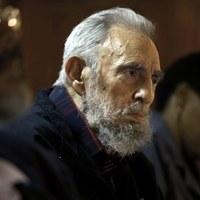Birán, 1926 – La Habana (Cuba), 2016
By Fernando Martínez Heredia
Fidel Castro Ruz, the son of a landowner, was born on August 13, 1926, in Birán, Mayarí. He studied at private schools, completing his primary and secondary education in Santiago de Cuba and later in Havana. He was a remarkable student and a sports enthusiast. He studied law at the University of Havana (UH), where he quickly became one of the leaders of the student federation (FEU). The country was experiencing a period of great political activity, with representative democracy and widespread corruption. The young Fidel participated in the struggle of the Cuban People’s Party (Orthodox) for moralization and reforms in favor of the people, but he also sought revolutionary action.
He was one of the members of the Cayo Confites expedition, which attempted to liberate the people of the Dominican Republic from the tyranny of Rafael Leónidas Trujillo (1946), and took part in the popular uprising in Bogotá following the assassination of Jorge Eliécer Gaitán (1948). On the same day as the coup d’état of March 10, he issued a manifesto condemning the dictatorship and began plotting against it. He led the “Movement”—a group of young people independent from traditional political opposition, advocating for armed struggle and a profound revolution. Operating in strict secrecy, these young people organized and prepared, and on July 26, 1953, they attacked the military barracks of La Moncada in Santiago de Cuba, the country’s second-largest city, and Bayamo.
The attack failed, and dozens of them were killed. Fidel and 27 others were captured and sentenced to prison. Tried alone, he delivered his famous defense speech, History Will Absolve Me. In the Modelo Prison, the “Moncadistas” remained steadfast, studied, and a popular movement secured their amnesty in May 1955. Immediately, they founded the 26th of July Revolutionary Movement (MR-26th of July) and began the path of insurrection. Fidel had to go into exile in early July 1955, traveling through several U.S. cities before settling in Mexico. There, he reunited with old comrades and new ones leaving Cuba and met Ernesto Che Guevara. The revolutionaries prepared themselves and, with great effort, managed to secure resources and a small yacht to fulfill the promise made to the Cuban people: “In 1956, we will be free or we will be martyrs.” The Granma yacht expedition landed at Las Coloradas, Oriente, on December 2, 1956.
The 25 months of revolutionary war transformed Fidel into the leader of the Cuban Revolution, turning the young rebel and brilliant intellectual into the guide of the people, military commander, and strategist of a complete transformation of the country and its citizens—an endeavor that seemed impossible given the need to confront the power of American imperialism (“[…] the war I’m going to wage against them. I realize this will be my true destiny” — Fidel to Celia Sánchez, June 6, 1958). When the Revolution triumphed, he became the uncontested leader and soon emerged as a prominent international figure. Prime Minister from February 1959 until December 1976, when the new Constitution came into force, he was elected President of the Council of State, a position to which he was reelected every five years until the present day.

Fidel carried out a massive task of popular education in the early years of the process, while simultaneously leading the country through its toughest challenges and the even more difficult task of making the economy and the socialist transition viable. The unity among the revolutionary forces and the constant effort to maintain unity among Cubans are among his greatest historical achievements. He was the leader and First Secretary of the Cuban Communist Party from its founding in 1965 until 2006, when he fell ill and had to step down from power. During this period, he was the greatest promoter of Cuba’s internationalist actions and consistently affirmed that international solidarity must be at the center of liberation ideas, including the possibility of moving ahead in today’s world. In his speeches in Caracas, at the UN, in Chile, in defense of Vietnam, and in numerous countries and international forums, he reaffirmed his stature as a revolutionary leader of global influence and a great strategist of the so-called Third World.
On July 31, 2006, Fidel Castro announced that he was stepping down from the Cuban government to undergo surgery. Power was then transferred to his brother, Raúl Castro. A little less than two years later, on February 19, 2008, the top leader of the Cuban Revolution resigned from the presidency of the Republic. Five days later, Raúl Castro was elected President of the Council of State. After nearly half a century of uninterrupted leadership, Fidel Castro withdrew from Cuba’s daily political life, dedicating himself from then on to writing articles for the Granma newspaper and receiving personalities or delegations visiting the island.
Fidel announced on July 31, 2006, the start of the transfer of presidential powers to his brother Raúl, who was then the island’s First Vice President, due to health problems. The process would take nearly two years to conclude, during which Raúl served as acting president. Officially stepping down in February 2008, Fidel maintained his political presence through a column in the Cuban Communist Party’s official newspaper Granma, his account on the social network Twitter, and occasional public or televised appearances.
Commander-in-Chief Fidel Castro died on October 25, 2016, at 10:29 p.m. at his home, at the age of 90. The announcement was made shortly afterward on state television by his brother Raúl, who declared nine days of official mourning. The international reaction was immediate. The revolutionary leader’s body was cremated in a private ceremony the following morning. His farewell drew millions of people to the Plaza de la Revolución, the site of countless speeches he delivered, and to the streets of Havana. His ashes traveled a thousand kilometers from Havana to Santiago de Cuba, retracing in reverse the path of the famous “Caravan of Liberty” led by Fidel after the overthrow of Fulgencio Batista.



